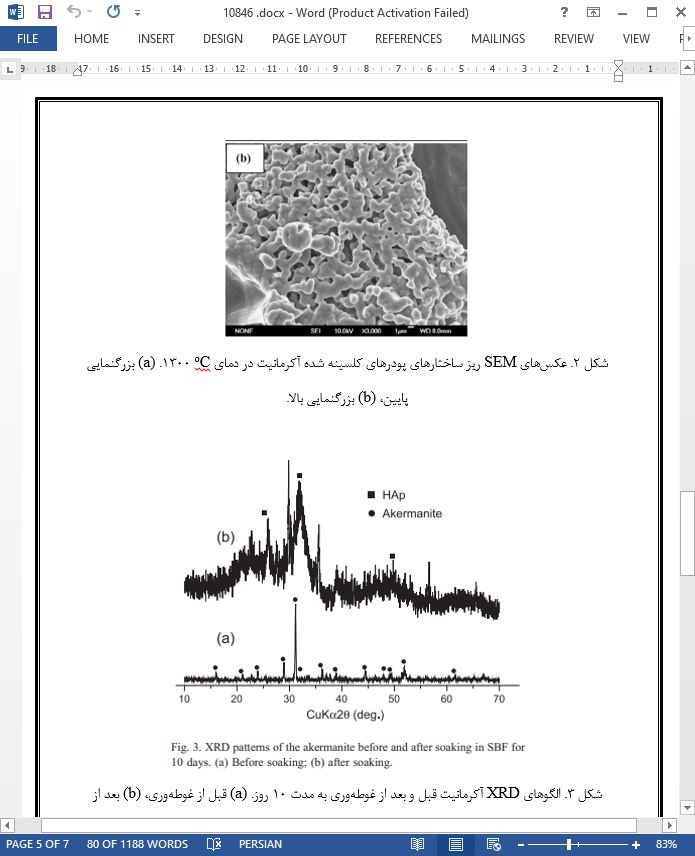
سنتز و توانایی تشکیل آپاتیت آکرمانیت
چکیده
پودرهای آکرمانیت خالص (Ca2MgSi2O7) به وسیله روش سل-ژل سنتز شدند. پودرهای آکرمانیت متشکل از ذرات چند بلوری (پلی کریستالی) با ابعاد µm 5-40 بودند. توانایی تشکیل آپاتیت آکرمانیت با غوطه وری آن در یک سیال شبیه سازی شده بدن (SBF: Simulated Body Fluid) بررسی شد، و نتیجه نشان داد که هیدروکسی آپاتیت (HAp) پس از 10 روز غوطه وری تشکیل شده است. مطالعات ما نشان داد که آکرمانیت دارای توانایی تشکیل آپاتیت بوده و ممکن است در تهیه بیومواد (زیست مواد) جدید بکار رود.
1. مقدمه
مطالعات پیشین نشان داده اند که تعدادی از شیشه ها و شیشه-سرامیک های حاوی Si، Ca و Mg بسیار زیست فعال بوده و می توانند در کابردهای پزشکی مورد استفاده قرار گیرند ]1-3[. علاوه بر این، گزارش شده که دیوپساید (CaMgSi2O6) یک سرامیک حاوی Si، Ca و Mg زیست فعال بوده و هنگامی که در بدن خرگوش ها کاشته می شود، پیوند قوی با بافت استخوانی برقرار می کند ]4-7[. به علت شباهت در ترکیب با دیوپساید، آکرمانیت (Ca2MgSi2O7) نیز یک سرامیک حاوی Si، Ca و Mg است. بنابراین، منطقی است که فرض کنیم آکرمانیت ممکن است یک ماده زیست فعال باشد. آکرمانیت یک ماده معدنی با دمای ذوب بیش از 1450 درجه سانتی گراد و چگالی g/cm3 2.944 بوده، که تاکنون کاربردهای صنعتی مهمی نداشته است. به طور طبیعی آکرمانیت اغلب به صورت خالص یافت نشده و همراه با دیگر مواد معدنی است، و با دانش ما هیچ گزارشی در مورد سنتز شیمیایی آکرمانیت خالص ارائه نشده است.
4. نتایج
به طور خلاصه، پودرهای آکرمانیت به وسیله ی روش سل-ژل سنتز شده و در دمای oC 1300 کلسینه شدند، و همچنین اندازه پودرهای آکرمانیت حدود µm 5-40 بود. مطالعه در شرایط آزمایشگاهی نشان داد که این پودرها میتوانند تشکیل هیدروکسی آپاتیت بر روی سطحشان را پس از 10 روز غوطه وری در SBF تحریک کنند. مطالعه ما پیشنهاد می کند که آکرمانیت توانایی تشکیل آپاتیت را دارد و می تواند یک کاندیدای بالقوه به عنوان بیومواد (زیست مواد) ترمیم کننده بافت باشد.
Abstract
Pure akermanite (Ca2MgSi2O7) powders were synthesized by sol – gel method. The akermanite powders were composed of polycrystalline particles with dimensions of 5 – 40 Am. The apatite-formation ability of the akermanite was examined by soaking it in a simulated body fluid (SBF), and the result showed that hydroxyapatite (HAp) was formed after soaking for 10 days. Our study indicated that akermanite possessed apatite-formation ability and might be used for preparation of new biomaterials.
1. Introduction
Previous studies have shown that some glasses and glassceramics containing Si, Ca and Mg were highly bioactive and could be used for biomedical applications [1– 3]. Furthermore, diopside (CaMgSi2O6), a Si, Ca and Mg containing ceramic, has been reported to be bioactive and closely bonded to bone tissue when implanted in rabbits [4 – 7]. As an analogue with diopside in component, akermanite (Ca2MgSi2O7) is also a Si-, Ca- and Mg-containing ceramic. Therefore, it is reasonable to assume that akermanite may be a bioactive material. Akermanite is a mineral, with a melting temperature of >1450 jC and a density of 2.944 g/cm3 , and so far has no important industrial applications. The naturally occurring akermanite was often not pure and associated with other minerals, and to our knowledge, there was no report about chemical synthesis of pure akermanite.
4. Conclusions
In summary, pure akermanite powders were synthesized by sol – gel method and calcination at 1300 jC, and the size of akermanite powders was about 5 –40 Am. The in vitro study showed that powders could induce hydroxylapatite formation on their surface after 10 days of soaking in SBF. Our study suggests that akermanite possessed apatite-formation ability and might be a potential candidate as tissue repair biomaterials.

چکیده
1- مقدمه
2- روش آزمایش
3- نتایج و بحث
4- نتیجه گیری
Abstract
1. Introduction
2. Experimental procedure
3. Results and discussion
4. Conclusions
- اصل مقاله انگلیسی با فرمت ورد (word) با قابلیت ویرایش
- ترجمه فارسی مقاله با فرمت ورد (word) با قابلیت ویرایش، بدون آرم سایت ای ترجمه
- ترجمه فارسی مقاله با فرمت pdf، بدون آرم سایت ای ترجمه
